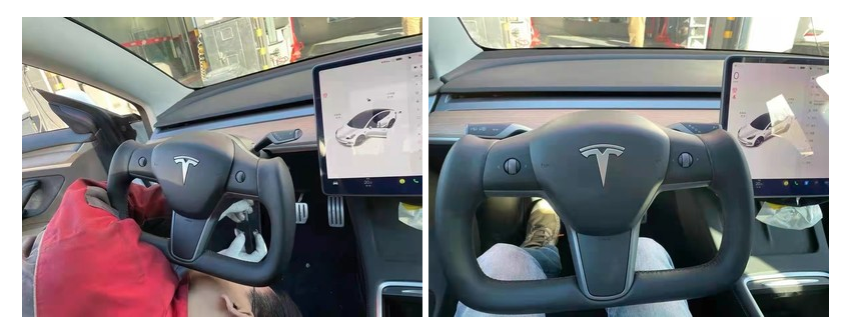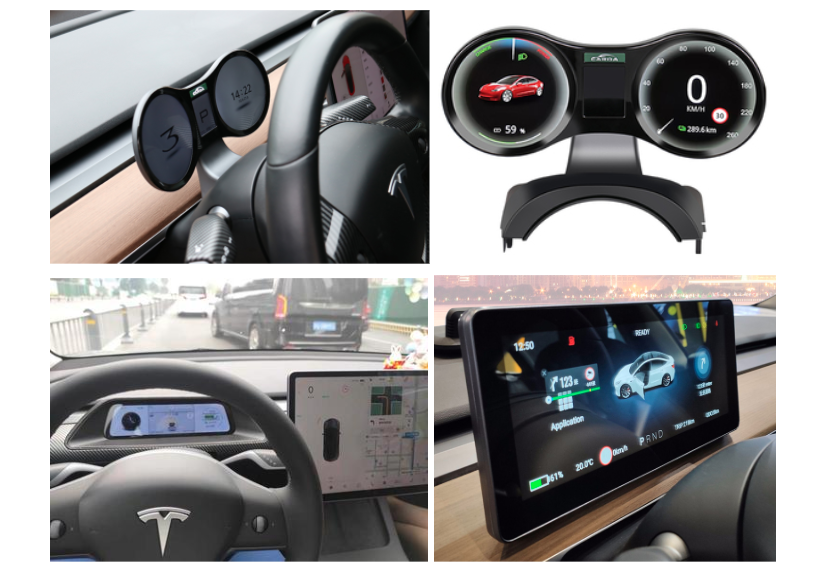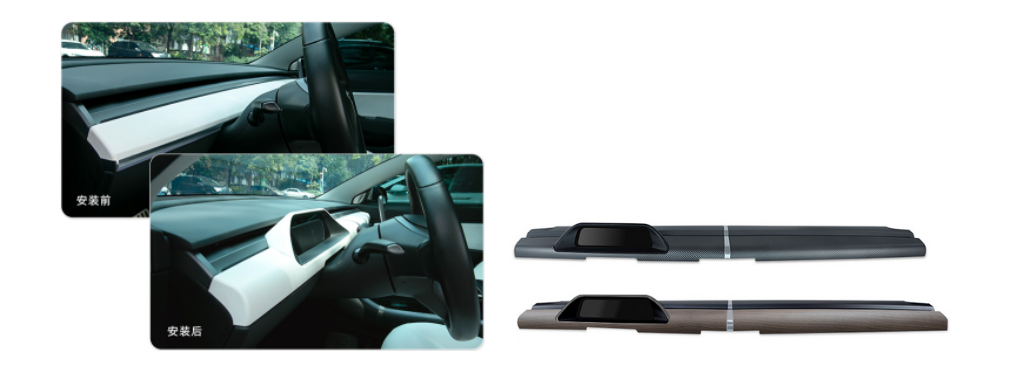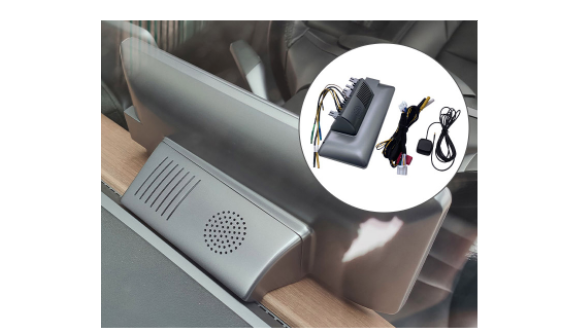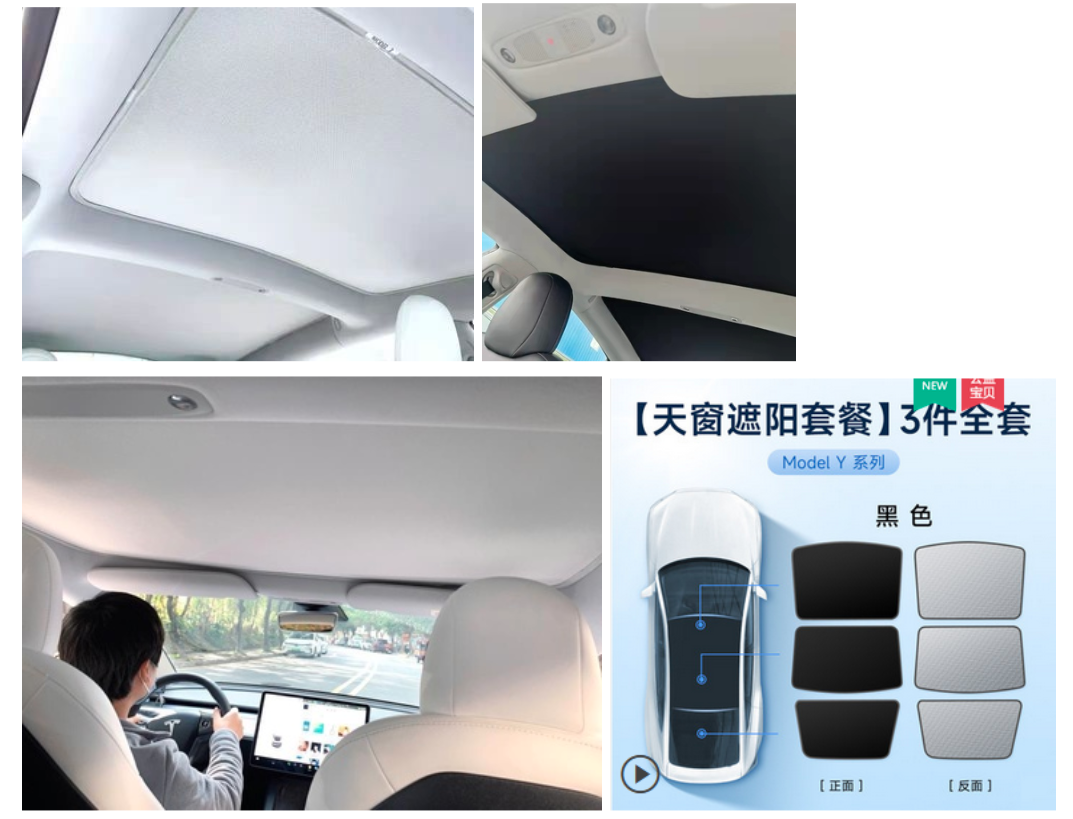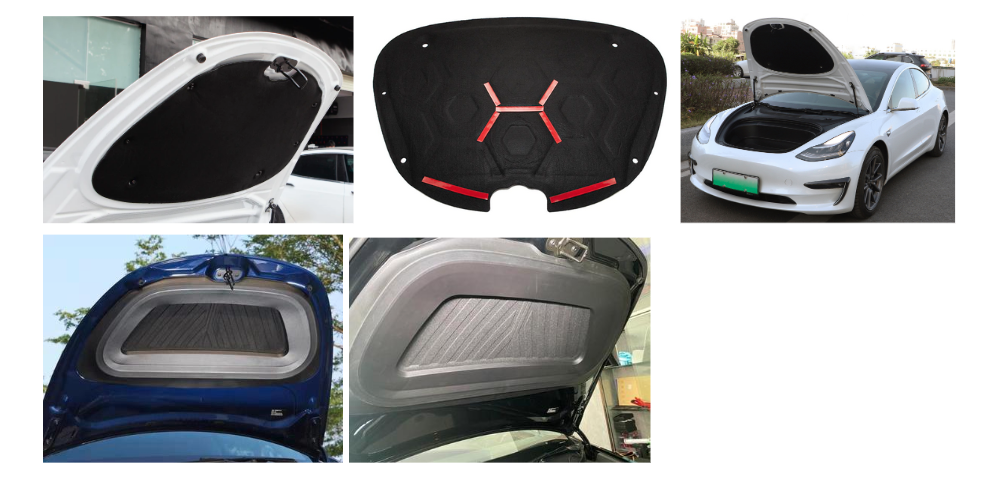Chinese car buyers may look for stuff to improve a car’s practicality, to make the vehicle easier to operate, or to improve its looks. Chinese consumers are helped by living in the “factory of the world,” with zillions of big and small accessory factories churning out everything from seat covers to body kits. These factories are amazingly fast and adaptive, able to design and produce new things in a heartbeat. Trends change fast in China; what is popular today may be completely forgotten next week. Pretty much every automaker does its best to keep up with these trends, though things were a bit different with Tesla. The started producing cars in Shanghai in 2019. Before local production started, Tesla was of course already famous, but sales of imported cars were slow. This was mainly due to a lack of supply. Tesla managed to build an entire factory in 10 months, which even for Chinese standards was pretty quick. But speed comes with a price. The shiny Model 3 and Model Y electric cars that run off the line are basically the same as U.S.-made cars, apart from the optional “China Red” color. That is not standard industry practice. Most major automakers have special localization departments in China, working from large R&D centers with ample resources available. These departments map local habits and trends and adjust their vehicles accordingly. The best known results are the famous “L” cars — long-wheelbase variants of relatively small vehicles. But that is just the top of the iceberg. Adjustments automakers make to vehicles to ready them for the Chinese market are sometimes basic, like having tinted windows as standard, while other times the changes can be more technical, like changing suspension settings (as Chinese drivers are known to prefer comfort over handling). So over a car’s lifetime, a China-made vehicle can change significantly compared to the original U.S. or Europe-made variant, even though they look basically the same.
China-made Tesla Model 3 in China Red (中国红). Tesla doesn’t have a dedicated localization department in China yet, which, simply said, means that the 3 and Y aren’t fully prepared for the particular demands of consumers in the Chinese market. This makes absolutely no difference in sales — China loves Tesla anyway — but it makes for an extra vibrant aftermarket improvement industry, with Chinese consumers willing to try to fit everything that they believe is cool. Some improvements were developed especially for Tesla, while others were adapted from existing products. Many aftermarket products appear to make the car less safe, even dangerously so, but that doesn’t bother consumers very much. Warranty issues are apparently not an issue either, and trademarks worry no one. The party may not last forever, as Tesla is planning a design center in Beijing. However, the center’s main goal seems to be the development of a new compact electric vehicle, not localization research. So for the foreseeable future, Chinese aftermarket inventors and loyal-yet-demanding consumers will continue to improve the Tesla Model 3 and Model Y on their own. Here’s an overview of the most extreme and interesting upgrades found on the Chinese interwebs.
Is This Some Kind Of Yoke?
Tesla has equipped the Model S and Model X with a Yoke steering wheel. Some like it, some don’t. Tesla doesn’t offer the Yoke in the Model 3 and Model Y, but Chinese Tesla owners want one anyway. And the rule in China is: If enough consumers want something they will get it. Inventive car part makers duly developed a sweet aftermarket conversion kit, replacing that boring old round wheel with a Yoke. Amazingly, the scroll wheels still work and some Chinese Yokes even have an airbag. Prices vary a lot, but a basic Yoke wheel costs around 1800 RMB (282 USD). There is a lot of choice in materials, colors and design details. You can get one in faux-leather, real leather, or suede. A heated version costs 200 RMB more. The conversion looks easy; sellers say any repair shop can do the job, and according to the reviews, many people even do it themselves.
Most buyers are happy with the Yoke, although some say that it takes a while to get used to. Some sellers offer wheels that look even more space-ship than the traditional Yoke, with handles at the top for more grip in orbit.
Dial Me Up, Elon
Mr. Musk famously dislikes instrument panels. If it were up to him, he would delete every instrument, and Neuralink speed and range directly into your brain. However, some favor dials. The Tesla Model 3 and Model Y don’t have any — just a big neck-killing screen. Happily, our creative Chinese entrepreneurs came up with a solution: retro-fit instrument panels that fit nicely in front of the steering wheel. There are dozens of sorts, sizes, and designs. Some are supported on the steering column and others on top of the dashboard.
Some go even further by fitting a new panel on the dashboard, allowing for a fully integrated instrument panel. Naturally, you can get your panel in any color, wood, or even carbonfiber: The instruments are wired directly into the main screen’s computer. All it takes is some data cable, connectors, and in some cases a CANBUS protocol box. The larger ones even have a built-in speaker! The functionalities of the instrument panels are controlled with the scrollers on the steering wheel.
Hold The Phone
Wat if you want dials, but you don’t want the same information that is on the big screen? You are a young and successful Chinese professional, so you want your eyes on your phone. At all times. Fortunately, there is a solution for that, too. Some variants of the instrument panel have a dual-function: they can show Tesla’s info and your phone at the same time. It works with Android Auto, Apple CarPlay, and Baidu CarLife.
Turn The Screen Around
What if you share Mr. Musk’s hatred for instrument panels, but you hurt your neck when looking at the big screen? The screen’s main problem is its positioning and angle. In a BMW, for example, the screen is angled towards the driver. Some Chinese electric car makers, like BYD, offer screens that rotate from portrait to landscape, so folks can find the perfect position for their needs. But Tesla doesn’t offer any of that fanciness. The big screen stands straight and won’t move. Until it does. Our smart Chinese stuff-makers came up with a screen with an adjustable angle. Some can turn only horizontally, with a max of 30 degrees. Others can turn horizontally and vertically. The fit is very simple: take off the screen, install a rotating bracket and some other parts, and put the screen back again.There is no need to disconnect any wiring. Pricing starts around 500 RMB (~$78).
HUDdle Up With Elon
Mr. Musk isn’t a fan of Head-Up Displays, either. There isn’t any HUD in any Tesla, but basically every other car maker in China offers HUDs these days. So Tesla can’t stay behind, can it now? Well, it’s not an issue, because of course our driven modificators found a way out: retrofit ’em! There are dozens of different systems available. Most show speed and range, others show more, like info on lights and doors. Installation is simple and many folks do it at home. The HUD device is very small and sits atop the dashboard. Basic models sell for 300 yuan ($46) and the most advanced ones for some 500 ($78).
The HUD taps into the car for the data it needs, with the wiring attached to a connector that is located under the air vents in the back. From there, the wire goes under the seats and on the dashboard. There, the wire sits behind a panel. Sadly, that panel isn’t easily moved by hand, so the HUD manufacturer provides a handy plastic tool to bend the panel just enough to allow the wire in.
Why Waste Charging Time?
Tray tables. On the left with dials, on the right with an angled screen. NIO does battery swaps. Takes only five minutes. Tesla got Supercharging. Takes half an hour. That’s a long time to waste. You can Youku on the big screen but that gets boring. How to maximize your charging time? Well, you can work. Or eat. Or drink tea. Or all of the above at the same time. Of course, you’ll want a table. Clever Chinese build-things companies thought of that too and developed foldable tray tables that fit nicely between driver and steering wheel.
The table is quite large, with holders for cups and other stuff. One could even use it when underway, but please don’t. When not in use, the table folds neatly into a bag.
There exists a smaller model as well that utilizes the steering wheel for stability. It is much smaller than a table but doesn’t take much space to store.
Other Trays and Tables
The vast majority of Chinese car owners have two well known oddities in their cars: a tissue box and car perfume box. When car ownership took off these two boxes wandered around the interior, without a place of their own. Then aftermarket companies began to develop all sorts of holders and trays for tissue boxes. Later again, Chinese car makers added special spaces for tissue boxes in their cars. Later once more, Western automakers found out about this and they too added spaces in their China-made vehicles, and in some cases even in imports.
The most popular tray table sits behind the main screen and can be ordered with a custom-made tissue box. But there are more high-tech solutions too:
This contraption fits behind the steering wheel as well. It has a smaller tissue box in the middle, two storage compartments, and two mobile-phone holders. For some extra fresh-scented air, you can use a compartment as a vase. But… What if you don’t like tissue tables behind the screen? It looks a bit odd from the outside and the tissues may get hot on a hot summer’s day. There is a simpler solution:
It works with a pouch that fits behind and below the screen, attached with velcro tape or a rubber band. You can even have one with Tesla branding. You won’t see that when the pouch is in use, but that’s like with those famous Pagani-branded screws on places that no owner ever goes: it feels just so good to know that it is there. Wipe on!
That Hot Sun
Many folks like Tesla’s panoramic sunroof. But under the bright Chinese sun, the interior may get hot. I can attest that no air conditioning, no matter how powerful, can handle a long ride on a dry day in southern China in summer. So how to fix that? With a handy sunscreen that covers the entire sunroof. Sellers claim temperature under the sunroof can go up to 75 degrees celsius. With the sun screen, they say, that goes down to a springy 25.
The sunroof covers come in many different colors and materials. Most are made up of three parts: one for the rear window and two for the roof. However, some sets also include a shade for the front windshield:
This works with a complex spider-like contraption mounted to the face of the screen, which will cause the loss of some functionality, it seems.I haven’t found any photos of folks using this sunshade so I guess it isn’t too popular. There is an umbrella-style variant as well which doesn’t base itself on the screen, but kind of hangs around in front of it. Not ideal either.
Let’s Go To Bed
With the sunscreen up it gets dark and you get tired. Too bad there isn’t a bed! But wait…
There is one! In China, you can order a bespoke-sized mattress for the Tesla Model 3 and Model Y. Down go the rear seats, in goes the bed, and on goes the cozy fire on the screen. There are many variants, as always. Air mattresses, foam ones, and others that are basically just a blanket. They are big enough for a man with shoes and a phone. The bed comes with a bag for storage in the frunk, next to a spare pack of tissues.
It’s A Multiplayer Karaoke World
Waiting while charging can be terribly boring, so when you don’t need to work or eat with that funky tray table we saw earlier on, you’ll want to play games. Tesla developed Arcade, a cool tool that lets you play videogames on the screen using the car’s pedals and steering wheel. But you can only play Arcade alone, and it doesn’t support karaoke. That is not good. Gamers like to game together in China and lots of Chinese-brand cars have built-in karaoke sets. Happily, a tiny USB hub and dock can solve all these problems. The hub fits into the glove box and connects to the screen. You can add two game controllers or a microphone via USB and your phone via Bluetooth. The microphone is Tesla-branded.
Come On Kill The Noise
Those electric cars make a lot of road/wind noise. That’s not cool when you are singing a song. Happily, there is a way to fix that. Chinese thinkers came up with various sound-deadening solutions for the 3 and Y. One popular accessory is a noise reduction mat that fits under the hood of the frunk. It’s easy to install and kills any frunky music. In the Model 3, the matte is large and covers almost the entire underhood. But that doesn’t work in the Model Y so it gets a smaller and more tailored mat (blue car shown above).
But there is much more sound deadening. Apparently, Chinese Tesla drivers are deeply concerned with this matter. They can get strips to seal the sunroof. z9Installation at home, with a handy tool). Or rubber strips to seal the doors; sellers claim the strips bring down noise from 77 dBA to only 38.3. There are also strips for the trunk and frunk lids.
This one is very interesting. It is a set of two complex shaped plastic deflector pieces that attach to the bottom of the frunk on a Model 3, one left and one right. Apparently someone put some research and design into this one. The seller says that normally, the wind going over the bonnet causes noise and dirt to enter the space between the frunk lid and the windscreen. With the pieces in place, wind and dirt passes over this space, up, and to the sides. The windscreen may get a little dirtier but hey that’s the price you pay.
Don’t Beep For The Belt
Chinese consumers are quite particular about safety. On one hand, they truly care if a car is safe, checking crash test results before they go shopping for a new car. On the other hand, they care much less about personal safety in the car. Installing after-market steering wheels and all sorts of other potential killer devices, like a sharp-edged tray behind the screen, is totally okay. In this same way, drivers in China don’t like to wear safety belts. It matters a bit where you are and how old the driver is. For example, down in the countryside nobody wears a belt but in big cities more people do. Older drivers don’t wear belts, no matter where they live, but younger folks are more open to it. For those who don’t wear belts, nothing is more annoying than the constant beeping and flashing of the seatbelt warning system. It drives a good man nuts. This problem was solved with auxiliary belt heads that don’t attach to an actual belt. They fit in every buckle and completely stop the warnings. These devices have been around for almost a decade now and it is somewhat amazing that they still work. One might expect the automakers to come up with a fix, like a sensor in the belt that checks if it is really pulled out. But nope.
There are other solutions. Instead of using a fake belt head, it is also possible to fool the warming system with a clip that covers the real belt head. The clip applies enough pressure to make the head believe it is in the buckle. The clip is attached to the belt with 3M, which doesn’t seem as solid and simple as the fake-belt head system. Naturally, you can get these with Tesla branding too.
Recap
One satisfied consumer who bought the USB hub left a recommendation that I’d like to quote here. He said: “There are always people who make up what Tesla is missing, making Tesla more perfect.” That sums it up perfectly. Tesla misses something, China makes up for that and makes Tesla better. Some of these Chinese inventions seem truly ingenious, like the screen with adjustable angle and the tissue trays. Which brings us to three important questions: 1. Why didn’t Tesla itself come up with some of these solutions? 2. Should Tesla itself develop and sell similar accessories? 3. If the answer to two is yes, which ones? My answers first: 1. They had no clue. 2. Yes. 3. The karaoke set and the tissue box tray. I always cry when I sing those sad Chinese love songs. General question – Was the “L” option to allow for the backseat passengers to have more room? In America it is “I am leaning the seat all the way back, if your legs are crushed not my problem” Also any info on how (if at all) China Red differs from the international red offered? Glad to see the aftermarket is still alive There is nothing I want more than a mid-size sedan stretched a bit to have limousine size back seats. I want a Camry Hybrid “L” size. I’d even upgrade to an Avalon or the Lexus equivalent to get a full-sized back seat. Some legitimate detailing shops can apply ceramic coatings that really do last a year or more. The process is more involved and I highly doubt many dealerships apply a true ceramic coating for that reason. Where’s the emergency gas powered generator? As soon as I started reading this I knew, without a doubt, there was going to be an entry on special tissue holders.



